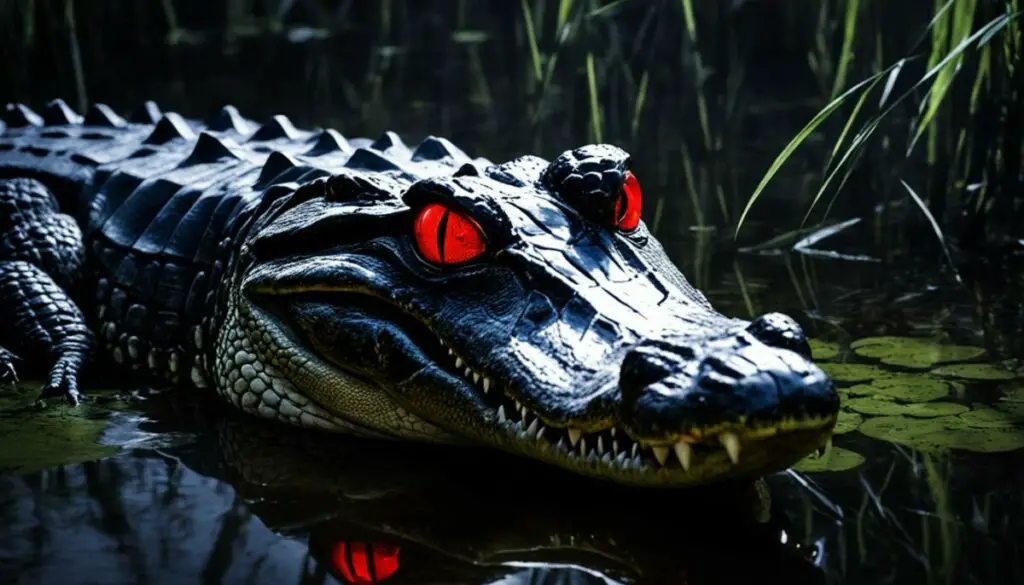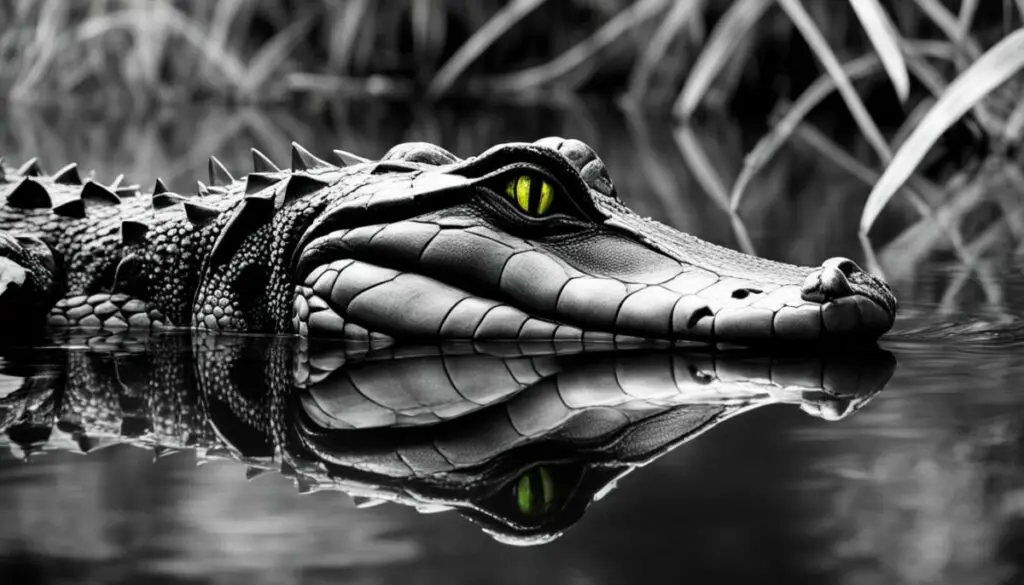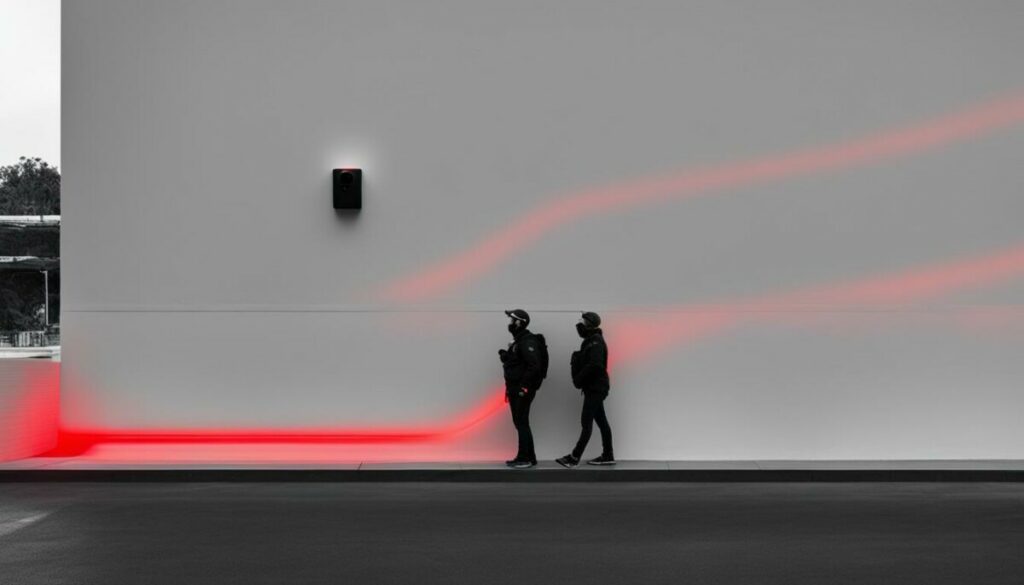Last Updated on 4 months by Francis
Humans rely on visible light to perceive the world around us, but there are other types of electromagnetic radiation that go beyond our visual capabilities. Infrared light, for example, provides valuable information about temperature. While we might assume that animals share our limited perception, nature often surprises us with remarkable adaptations. This leads us to wonder: can alligators, as reptiles, see in the infrared spectrum?
Alligators, like many other animals, possess unique sensory abilities that allow them to thrive in their environments. Their faces, in particular, have been the subject of fascination. Tiny bumps known as integumentary sensory organs (ISOs) cover their jaws and mouths. Research has revealed that these ISOs are incredibly sensitive, suggesting that alligators’ faces possess heightened sensory powers. But can they extend this sensitivity to perceiving infrared light?
While scientists have made significant discoveries about alligators’ sensory capabilities, the mystery surrounding their perceived infrared vision remains unsolved. Researchers continue to study these ancient reptiles to unlock the truth about their sensory perception, including the potential of seeing in the infrared spectrum.
Contents
Key Takeaways:
- Alligators possess sensory organs called integumentary sensory organs (ISOs) on their faces that make them highly sensitive to touch.
- The specific purpose of these ISOs and their potential connection to infrared vision in alligators are still not fully understood.
- The study of alligators’ sensory capabilities can contribute to advancements in various fields, such as wildlife observation and conservation, medical imaging, and security applications.
- Thermal cameras, which detect heat signatures, can be utilized for personal safety, wildlife encounters, and enhancing security measures.
- Infrared technology, including thermal cameras, has a range of applications in medical settings, aiding in diagnosis and treatment planning.
The Sensory Powers of Alligators’ Faces

Alligators possess a fascinating anatomical feature on their faces that sets them apart from humans – tiny bumps that are actually more sensitive than our own fingertips. These bumps, scientifically known as integumentary sensory organs (ISOs), are located on the jaws and inside the mouths of alligators. Interestingly, they can also be found on the scales of other crocodilian species.
Recent research has shed light on the purpose and functionality of these ISOs. Studies have revealed that these seemingly minute bumps are, in fact, touch sensors intricately connected to a network of nerve endings. This remarkable discovery suggests that despite their tough scales, alligators’ faces possess an exceptional level of sensitivity.
“Alligators’ faces are exquisitely sensitive despite their tough scales.”
Given this heightened touch sensitivity, it naturally begs the question: can these sensory organs also detect infrared light? The ability to perceive infrared would provide alligators with a unique advantage, enabling them to navigate their surroundings in ways that humans and many other animals simply cannot.
To explore this possibility, researchers are delving deeper into the sensory powers of alligators’ faces. By examining the structure of the integumentary sensory organs and conducting experimental studies, scientists aim to uncover whether these sensory organs play a role in the detection and perception of infrared light.
Unlocking the Secrets of Infrared Detection
The connection between alligators’ ISOs and infrared detection has yet to be fully understood. However, as our knowledge of the biological mechanisms underlying sensory perception expands, exciting possibilities emerge. If alligators exhibit the ability to detect infrared, it would add another fascinating layer to our understanding of their sensory capabilities.
The image above showcases the intricate ISOs on an alligator’s face, underscoring their potential role in detecting infrared light. As research continues, scientists are eagerly exploring the implications of alligators’ sensory powers, particularly in the realm of infrared perception.
The Mystery of Alligators’ Infrared Perception

While it is known that alligators have sensory organs that can detect touch, the ability to see in the infrared spectrum is still a mystery. The specific purpose of these integumentary sensory organs and whether they have any connection to infrared detection is not yet fully understood. Researchers continue to study alligators and their sensory abilities to uncover the truth about their perception of the infrared.
One prevailing theory suggests that alligators may have the ability to see in the infrared spectrum, similar to some snakes. Snakes have specialized organs called pit organs, which allow them to detect heat signatures and infrared radiation from their surroundings. It is possible that alligators have a similar mechanism, but further research is needed to confirm this hypothesis.
Scientists are exploring different methods to investigate the presence of infrared vision in alligators. One approach involves using thermal imaging cameras to study the visual responses of alligators to varying temperatures. By observing how alligators react to different heat sources, researchers can gather valuable insights into their sensory capabilities.
Additionally, researchers are examining the genes and proteins present in the integumentary sensory organs of alligators. By identifying specific genes that are responsible for detecting infrared radiation, scientists may be able to determine if alligators have the biological machinery necessary for infrared vision.
The findings from these studies could have significant implications not only for understanding alligator vision but also for broader scientific and technological advancements. If alligators are indeed capable of perceiving the infrared spectrum, it could have applications in fields such as wildlife conservation, search and rescue operations, and even the development of advanced imaging technologies.
Current Research Initiatives
Several research initiatives are underway to explore the mysteries surrounding alligators’ infrared perception. Here are some notable projects:
- The Florida Alligator Infrared Vision Study: This ongoing study aims to investigate the visual capabilities of alligators, particularly their ability to perceive infrared radiation. Researchers are conducting controlled experiments using thermal imaging technology and analyzing the physiological responses of alligators to varying levels of infrared radiation.
- The Genetic Mapping Project: Researchers are conducting genetic mapping studies to identify specific genes and proteins associated with the integumentary sensory organs of alligators. By comparing the genetic profile of alligators with other reptiles known for their infrared vision, such as snakes, scientists hope to uncover the genetic basis of infrared perception.
- The Behavioral Observation Study: This study involves observing the behavior of alligators in different thermal environments. Researchers are monitoring how alligators react to changes in temperature and assessing whether their responses align with the presence of infrared vision. This research provides important behavioral insights into the sensory capabilities of alligators.
Through these research initiatives, scientists are gradually unraveling the mystery of alligators’ infrared perception. While the full extent of their vision remains uncertain, each discovery brings us closer to understanding the fascinating sensory world of these ancient reptiles.
Exploring the Applications of Infrared Technology

Infrared technology has a wide range of practical applications across various industries. In the context of studying alligators’ sensory abilities, it presents an opportunity to gain valuable insights into their perception of the world.
If alligators are indeed capable of detecting infrared light, this discovery could have significant implications in different fields. Let’s explore some of these applications:
1. Wildlife Observation and Conservation
Alligators possess extraordinary infrared sensory capabilities that enable them to navigate their environment with precision.
By understanding how alligators detect infrared, researchers can develop innovative methods for monitoring and studying wildlife populations. Utilizing infrared technology may provide valuable data on animal behaviors, migration patterns, and habitat preferences.
2. Medical Imaging
Infrared technology has already made significant advancements in the field of medical imaging, such as thermal cameras that can detect temperature variations in the body.
Studying alligators’ ability to detect infrared light could help refine and enhance existing medical imaging techniques, leading to improved diagnosis and treatment planning. For example, the integration of infrared technology in identifying specific areas of inflammation or abnormality could revolutionize healthcare practices.
3. Military and Security Applications
The alligator’s innate ability to perceive infrared light could have tremendous potential in military and security applications.
They are masters of camouflage and can remain virtually undetectable.
By understanding and replicating the alligator’s infrared sensory capabilities, researchers could develop advanced camouflage technologies or sensors for military use. Additionally, infrared detection systems could enhance security measures by identifying potential threats that may be concealed from traditional surveillance methods.
These are just a few examples of how studying alligators’ ability to detect infrared light could lead to advancements across various industries.
The image above showcases the intricate sensory mechanisms of alligators and their potential to perceive infrared light. Further research and innovation in this field will undoubtedly drive new discoveries and applications.
Thermal Cameras and Dating Safety

Thermal cameras, typically associated with detecting heat signatures, can also have practical applications for personal safety, including dating. On Valentine’s Day, a thermal camera can be used to ensure the health of potential partners by detecting signs of fever or elevated body temperature, which could be indicative of illness. Additionally, a thermal camera can help identify concealed weapons, providing an extra layer of security in potentially dangerous situations.
By using thermal cameras for dating safety, individuals can prioritize their well-being and the safety of their loved ones. With the ability to detect subtle changes in body temperature, thermal cameras can help identify potential health risks and reduce the transmission of infectious diseases, especially during the current global pandemic.
Furthermore, thermal cameras play a crucial role in enhancing personal safety and security. Whether meeting someone for the first time or going on a blind date, a thermal camera can provide peace of mind by highlighting potential health concerns and identifying hidden dangers.
Using Thermal Cameras on Valentine’s Day
Valentine’s Day, a holiday celebrated by couples worldwide, presents an opportunity to incorporate thermal camera technology into dating experiences. By incorporating this innovative tool, individuals can prioritize their safety while enjoying romantic festivities.
Here’s how thermal cameras can be used on Valentine’s Day:
- Health Screening: Before embarking on a romantic date, both individuals can undergo a quick temperature check using a thermal camera. This simple precaution can help identify any signs of fever or elevated body temperature, allowing potential health risks to be addressed promptly.
- Early Detection: Thermal cameras can help identify possible symptoms of illness even before they become obvious. By detecting subtle changes in body temperature, these cameras can alert individuals to potential health concerns, providing an opportunity to seek medical advice and minimize the risk of spreading illness to others.
- Security Measures: In addition to health screening, thermal cameras can aid in identifying concealed weapons. This added layer of security can help create a safer environment for both individuals, ensuring that romantic outings are free from potential threats.
Overall, incorporating thermal cameras into dating scenarios on Valentine’s Day enhances safety, promotes well-being, and brings peace of mind to individuals looking to enjoy a memorable and secure experience.
With thermal cameras, dating safety reaches new heights, empowering individuals to make informed decisions, prioritize health, and protect one another.
| Benefits of Using Thermal Cameras for Dating Safety |
|---|
| 1. Health screening: Detect signs of fever or elevated body temperature |
| 2. Early detection: Identify potential health concerns before they become apparent |
| 3. Security measures: Identify concealed weapons for enhanced safety |
Preventing Wildlife Encounters with Thermal Cameras

When planning outdoor activities, especially in areas known to have dangerous wildlife like crocodiles and snakes, it’s crucial to be aware of potential threats. Luckily, thermal cameras can serve as valuable tools for detecting and avoiding these animals, ensuring a safer experience in natural habitats.
Thermal imaging technology allows individuals to spot crocodiles and snakes from a distance, even in low-light or camouflaged environments. By detecting the heat signatures of these creatures, thermal cameras provide an added level of awareness and protection.
Using a thermal camera during outdoor activities such as hiking, camping, or wildlife photography can help adventurers navigate their surroundings more safely. By identifying potential threats in advance, individuals have the opportunity to adjust their paths, maintain a safe distance, and avoid unnecessary encounters.
Key Advantages of Thermal Cameras for Outdoor Activities:
- Early detection: Thermal cameras can spot crocodiles and snakes before they become a close threat, giving individuals time to react and avoid potential danger.
- Enhanced safety: By providing an extra layer of protection, thermal cameras empower outdoor enthusiasts to explore natural habitats more confidently.
- Peace of mind: Knowing that potential wildlife encounters can be detected and avoided helps individuals relax and enjoy their outdoor adventures fully.
Whether you’re an avid hiker, nature enthusiast, or wildlife photographer, equipping yourself with a thermal camera is a wise decision. By investing in this cutting-edge technology, you can embark on outdoor activities with greater peace of mind, knowing that you have an effective tool to prevent wildlife encounters.
| Benefits of Using Thermal Cameras for Wildlife Detection | Benefits of Using Thermal Cameras for Outdoor Activities |
|---|---|
| 1. Early detection of crocodiles and snakes | 1. Early detection of potential threats |
| 2. Increased safety in wildlife-rich areas | 2. Enhanced overall safety during outdoor activities |
| 3. Prevention of dangerous encounters | 3. Peace of mind and improved enjoyment of outdoor adventures |
Enhancing Security with Thermal Cameras

Thermal cameras play a significant role in enhancing security measures. These advanced devices have the ability to detect concealed weapons and identify suspicious activities that may not be visible to the naked eye. By using thermal cameras, security personnel can have an additional tool at their disposal to enhance safety and maintain public order.
One of the major advantages of thermal cameras for security is their ability to detect concealed weapons. Unlike traditional metal detectors, which only identify metallic objects, thermal cameras can detect any object that emits heat, including non-metallic weapons such as plastic knives or ceramic guns. This makes thermal cameras an invaluable asset in preventing potential threats and ensuring the safety of individuals in public spaces.
Thermal cameras can be employed in various settings to enhance security, including airports, stadiums, hotels, and other areas with a high volume of people. These devices provide a non-invasive and efficient method for identifying potential threats, ensuring the safety and well-being of everyone present.
By utilizing thermal imaging technology, security personnel can identify individuals who may be carrying concealed weapons or exhibiting unusual heat signatures. This allows for prompt intervention and preventive measures, minimizing the risk of unwanted incidents and ensuring the protection of both staff and visitors.
Did you know? Thermal cameras are even used in law enforcement agencies and military operations to detect hidden threats and facilitate efficient response strategies.
Quote: “With the use of efficient thermal cameras, security personnel can quickly and accurately identify potential threats, ensuring a safer environment for everyone.” – Security Expert
Moreover, the benefits of thermal cameras extend beyond weapon detection. These devices can also help security personnel identify suspicious activities, such as trespassing, vandalism, or unauthorized access to restricted areas. By detecting anomalies in heat patterns, thermal cameras enable proactive security measures, preventing potential intrusions and reducing the risk of criminal activities.
Note: Thermal cameras can be seamlessly integrated with existing security systems, providing a comprehensive surveillance solution that combines traditional video cameras with advanced thermal imaging capabilities. This integration allows for more robust monitoring and swift response to potential threats.
Table: Advantages of Using Thermal Cameras for Security
| Advantages | Benefits |
|---|---|
| Detecting concealed weapons | – Ensures the safety of individuals – Reduces the risk of violent incidents |
| Identifying suspicious activities | – Prepares security personnel to respond promptly – Deters criminal behavior |
| Integrating with existing security systems | – Enhances overall surveillance capabilities – Streamlines monitoring and response processes |
The application of thermal cameras in security measures is an innovative approach that provides an extra layer of protection and sets a new standard in ensuring public safety. By using thermal cameras to detect concealed weapons and identify suspicious activities, security personnel can proactively prevent potential threats and maintain a secure environment.
The Advantages of Thermal Cameras in Medical Settings
Infrared technology and thermal cameras have revolutionized healthcare by providing non-invasive and real-time diagnostic capabilities. The applications of thermal cameras in medical imaging are vast, offering valuable insights into various aspects of patient care.
One of the key advantages of thermal cameras is their ability to detect fevers and monitor body temperature. By capturing and analyzing the thermal patterns emitted by the human body, healthcare professionals can quickly identify potential signs of infection or illness. This early detection can be critical in preventing the spread of contagious diseases and initiating prompt treatment.
Furthermore, thermal imaging can be used to identify specific areas of inflammation or other abnormalities in the body. By visualizing the variations in heat distribution, healthcare providers can pinpoint areas of concern and develop targeted treatment plans. This technology has proven particularly useful in fields such as dermatology, where it aids in the identification of skin conditions and guides treatment decisions.
Thermal cameras also offer a non-invasive alternative for monitoring patients’ vital signs, such as heart rate and respiration. Without the need for physical contact or intrusive procedures, healthcare professionals can gather vital information accurately and efficiently.
In addition to its diagnostic applications, the use of thermal cameras in surgical settings has gained popularity. These cameras can help surgeons visualize blood flow, identify areas of ischemia, and assess tissue viability during procedures. By providing real-time feedback, thermal imaging contributes to more precise surgical interventions and improved patient outcomes.
| Advantages of Thermal Cameras in Medical Settings |
|---|
| Early detection of fevers and potential signs of illness |
| Identification of specific areas of inflammation or abnormalities |
| Non-invasive monitoring of vital signs |
| Visualization of blood flow and tissue viability during surgical procedures |
As thermal camera technology continues to evolve, it holds promise in advancing medical imaging even further. The ability to capture high-resolution thermal images and integrate them with other modalities opens up new possibilities for comprehensive and detailed assessments. From cardiology to neurology, thermal cameras have the potential to transform the way healthcare is delivered.
By utilizing thermal imaging, healthcare professionals can gather valuable diagnostic information non-invasively and in real-time, aiding in accurate diagnosis and treatment planning.
As we unlock more of the potential of infrared technology in healthcare, the possibilities for improving patient care and outcomes continue to expand. Thermal cameras are proving to be valuable tools in the medical field, providing insights that were previously unattainable. With ongoing advancements and research, the future of thermal imaging in healthcare holds immense promise for revolutionizing the way we diagnose, monitor, and treat a wide range of medical conditions.
Conclusion
The question of whether alligators can see in the infrared spectrum remains unanswered. While it is known that they have sensory organs capable of detecting touch, further research is needed to determine if these organs are involved in the perception of infrared light.
The potential applications of thermal cameras extend beyond alligators and can be beneficial in various areas, including personal safety, wildlife encounters, security, and healthcare. By utilizing thermal imaging technology, we can enhance our understanding of the environment and improve safety measures.
As technology continues to advance, our understanding of alligators’ sensory capabilities and the broader applications of infrared technology will continue to evolve. Whether it is exploring the mysteries of alligators’ infrared perception or using thermal cameras for medical imaging, infrared technology holds immense potential for further research and innovation.
FAQ
Can alligators see in the infrared spectrum?
The ability of alligators to perceive infrared light is still not fully understood. While they have sensory organs that can detect touch, whether these organs are involved in infrared detection is unknown.
Do alligators have infrared vision?
It is currently unclear if alligators have infrared vision. Research is ongoing to determine the sensory capabilities of alligators and their ability to perceive infrared light.
Can reptiles see in the infrared spectrum?
Some reptiles, such as snakes, are known to have infrared vision. However, whether alligators specifically possess this ability is still under investigation.
How do alligators perceive infrared?
The specific mechanisms through which alligators may perceive infrared light are not yet known. Further research is needed to understand their sensory abilities in relation to infrared detection.
What are the applications of infrared technology?
Infrared technology has various practical applications, including wildlife observation and conservation, medical imaging, and military and security applications. Understanding how alligators perceive infrared could lead to advancements in these areas.
How can thermal cameras enhance personal safety, including dating?
Thermal cameras can be used to detect signs of fever or elevated body temperature, which could indicate illness. This can help ensure the health of potential partners, especially on occasions like Valentine’s Day.
Are thermal cameras useful for detecting wildlife threats?
Yes, thermal cameras can help spot dangerous wildlife like crocodiles and snakes from a distance, allowing individuals to navigate their surroundings more safely during outdoor activities.
How can thermal cameras enhance security measures?
Thermal cameras can detect concealed weapons or suspicious activities that may not be visible to the naked eye. They can be used in public spaces, like airports and stadiums, to identify potential threats and maintain public order.
What are the advantages of thermal cameras in medical settings?
Thermal cameras can assist in detecting fevers, monitoring body temperature, and identifying areas of inflammation or abnormalities. They provide non-invasive and real-time diagnostic information for accurate diagnosis and treatment planning.
Can alligators see in the infrared spectrum? (Conclusion)
While it is known that alligators have sensory organs capable of detecting touch, their ability to perceive infrared light is still a mystery. Ongoing research aims to uncover the truth about alligators’ sensory abilities and their potential to detect infrared.
Source Links
- https://viewspace.org/interactives/unveiling_invisible_universe/forms_of_light/infrared_animals
- https://www.nationalgeographic.com/science/article/crocodile-faces-are-more-sensitive-than-human-fingertips
- https://perfectprime.com/blogs/blog/love-in-the-eyes-of-a-thermal-camera-5-uncanny-ways-infrared-can-save-your-valentine-s-2022








